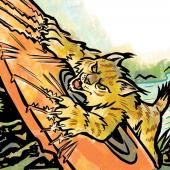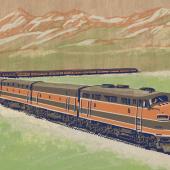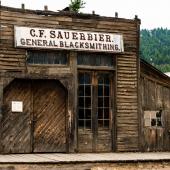Wild West Words: SCALAWAG, GADABOUT & PICTOGRAPH
Department Heritage
SCALAWAG
Nowadays, a scalawag is little more than a rascal or scamp. This seemingly innocuous word, however, once had some very sharp teeth.

In the post-Civil War South, a scalawag was a local who supported reconstructionary measures, hoping to profit from cooperating with the Republican administration in the North. In some documents from the era, scalawags were compared to “foul lepers” and deemed “low persons of the baser sort.” Considered more vile than Northern carpetbaggers, Southern scalawags were compared to traitors.
But the North had its scalawags too, and they showed up decades before their Dixieland counterparts. The Dictionary of Americanisms, published in 1848, referred to scalawag as an “epithet in Western New York for a mean fellow, a scapegrace.” In Trade Union slang, a scalawag was a lazy, recalcitrant man.
Yet another definition of the word, and probably its original sense, is “a lean, scrawny, undersized horse.” This leads some etymologists to speculate that scalawag derives from the isle of Scalloway in Scotland’s Shetland Islands, known for its populations of small ponies, which are of little value as work animals. From this, scalawag may have evolved to mean “morally stunted person, one who will not work.” But this is only an educated guess offered by word-watchers. Every dictionary admits that the origin of the word scalawag is either uncertain or unknown.
GADABOUT
A gadabout is a social sampler, roving from place to place seeking companionship, gossip or amusement. Poet and novelist Sir Walter Scott wrote in 1817 of “the frivolous…gad-about manner of…our modern belles.” In 1851, British writer Sir Alfred Helps scoffed about “Foolish gad-about, dining, dancing people.”

Restless gadabouts are etymologically driven by stinging flies; specifically the gadfly, the European analogue of the North American horsefly or deerfly. These three species are members of the Tabanidae family of biting flies — swarming, stinging insects that drive livestock and wild herds mad, and can deliver painful punctures to human flesh as well.
The European gadfly derives its name from gad, an Old Norse word meaning “sharp spike of metal or wood.” The word goad, referring to a pointed rod for driving cattle, is a close relative. Etymologically, when the gadfly bites, it’s as if a gad, or a spike, is piercing the skin.
Gadabouts, then, in their search for amusements, perambulate hither and thither like animals driven to distraction by the sting of the gadfly.

PICTOGRAPH
For thousands of years, humans have been creating pictographs, figures and icons commonly found on rock surfaces in caves and shelters around the world. The famous pictographs or “cave drawings” of bison, reindeer, lions and wild horses in France’s Lascaux Caves have been dated at 30,000 years old. These prehistoric murals were created with paints made from ground iron oxide or charcoal. The yellow, black and red powder was mixed with animal fat and applied to the rock with fingers and hair brushes.
Prehistoric North Americans used these techniques to create paintings on shelter and cave walls throughout the West. Dated at 2,000 years old, the paintings at Pictograph State Park in Billings feature human, animal, and abstract figures.
The term invented to describe these paintings, pictograph, first appeared in the English language in approximately 1851. It’s a merging of Latin and Greek: picto is from the Latin pictus, “painted,” and the second portion, graph, is a derivative of the Greek verb graphien, “to write.” Etymologically, a pictograph is “painted writing.”












Leave a Comment Here